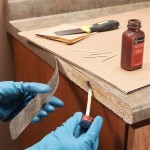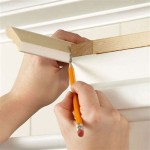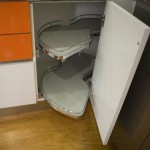How to Get Musty Smell Out of Kitchen Cupboards
A musty odor emanating from kitchen cupboards can be a persistent and unpleasant problem. This smell often indicates the presence of mold or mildew, which thrive in damp, poorly ventilated environments. Addressing this issue promptly is crucial, not only for eliminating the odor but also for preventing potential health concerns and damage to the cupboard structure. This article provides a comprehensive guide to identifying the cause of the musty smell and implementing effective strategies to eradicate it.
Identifying the Source of the Musty Smell
Before attempting to remove the musty smell, it is essential to pinpoint its origin. The odor could stem from various sources, including food spills, water leaks, or condensation. A thorough inspection of the cupboards is the first step. Begin by emptying all contents, including dishes, cookware, and food items. Examine the shelves, walls, and corners of the cupboards for visible signs of mold or mildew. These may appear as small black, green, or white spots. Pay close attention to areas around plumbing fixtures, such as the sink or dishwasher, as water leaks are a common cause of dampness.
Check for any signs of water damage, such as discoloration, warping, or peeling paint. These can indicate a hidden leak that is contributing to the musty smell. Run a hand along the surfaces inside the cupboard to feel for dampness. This is especially important in corners and along the bottom, where moisture tends to accumulate. Sniff around various areas of the cupboard to determine the location of the strongest odor, which will help narrow down the source. If the smell is concentrated in a specific area, focus the cleaning efforts on that spot.
Furthermore, examine the items that were stored in the cupboards. Food containers, especially those with tight-fitting lids, can trap moisture and promote mold growth. Spices and other dry goods can also absorb moisture from the air and become musty. Check for expired or spoiled food items that may be contributing to the odor. Discard any items that show signs of mold or mildew, or that have a lingering musty smell. Clean any reusable containers thoroughly before returning them to the cupboards.
Cleaning and Disinfecting the Cupboards
Once the source of the musty smell has been identified, the next step is to thoroughly clean and disinfect the affected cupboards. Several cleaning solutions are effective at removing mold and mildew, each with its own advantages and disadvantages. Before using any cleaning solution, it is recommended to test it on a small, inconspicuous area of the cupboard to ensure it does not damage the finish. Always wear gloves and eye protection when working with cleaning solutions to protect the skin and eyes.
A solution of diluted bleach is a commonly used disinfectant. Mix one part bleach with ten parts water. Apply the solution to the affected areas using a sponge or cloth. Allow the solution to sit for several minutes to kill any mold or mildew spores. Rinse the area thoroughly with clean water and dry it completely. It is important to note that bleach can discolor some surfaces, so it should be used with caution. Additionally, ensure adequate ventilation when using bleach, as it can release harmful fumes.
White vinegar is a natural and effective cleaning agent that can kill mold and mildew. It is also less harsh than bleach and does not produce harmful fumes. To use vinegar, simply spray it undiluted onto the affected areas and let it sit for an hour. Then, wipe the area clean with a damp cloth and dry it thoroughly. Baking soda is another natural cleaning agent that can help absorb odors. Sprinkle baking soda onto the shelves and walls of the cupboards and let it sit for several hours, or even overnight. Then, vacuum or wipe away the baking soda.
For particularly stubborn stains or mold growth, a specialized mold and mildew remover may be necessary. These products are available at most hardware stores and home centers. Follow the manufacturer's instructions carefully when using these products. After cleaning the cupboards with any of these solutions, allow them to air dry completely before replacing any items. This will help prevent the recurrence of mold and mildew growth.
Preventing Future Musty Smells
Once the musty smell has been eliminated, it is important to take steps to prevent it from returning. Maintaining proper ventilation in the kitchen is crucial. Open windows and doors regularly to allow fresh air to circulate. Use exhaust fans when cooking or washing dishes to remove excess moisture from the air. Consider using a dehumidifier to reduce the humidity level in the kitchen, especially during humid months.
Regularly clean and inspect the kitchen cupboards for signs of water damage or mold growth. Promptly address any leaks or spills to prevent moisture from accumulating. Avoid overloading the cupboards, as this can restrict airflow and create a damp environment. Store food items in airtight containers to prevent them from absorbing moisture and becoming musty. Periodically wipe down the shelves and walls of the cupboards with a damp cloth to remove dust and dirt.
Consider using moisture absorbers in the cupboards. These products contain substances that can absorb excess moisture from the air, helping to prevent mold and mildew growth. Silica gel packets are a common type of moisture absorber that can be placed in corners or along the back of the cupboards. Replace these packets regularly as they become saturated with moisture. Charcoal briquettes can also be used as a moisture absorber. Place a few briquettes in a container and set it in the cupboard. Replace the briquettes every few months.
Ensure proper air circulation within the cupboards. Avoid lining the shelves with solid materials, such as plastic or rubber, as these can prevent air from circulating. Instead, use breathable liners, such as paper or fabric. Leave a small gap between items stored in the cupboards to allow air to flow freely. By implementing these preventive measures, it is possible to maintain a clean, fresh-smelling kitchen and avoid the recurrence of musty odors.
Finally, address any underlying structural issues that may be contributing to moisture problems. If there are persistent leaks or condensation problems, consult with a qualified professional to identify and repair the source of the issue. This may involve repairing plumbing fixtures, improving insulation, or addressing ventilation problems. By addressing these underlying issues, it is possible to create a healthier and more comfortable kitchen environment.

Musty Smell In Kitchen Cabinets Cupboards Causes Solutions

Musty Smell In Kitchen Cabinets Cupboards Causes Solutions

Getting Rid Of The Musty Old Smell From Your Cabinets N Hance Wood Refinishing Franklin Murfreesboro

Help With Odor In Kitchen Cabinets Hometalk

How To Get A Musty Smell Out Of Furniture Once For All

How To Get Rid Of Musty Smell In Kitchen Cupboards Effective Tips Solutions

Get Funky Musty Smells Out Of Your Cabinets With A Few Items You Already Own

How To Get Rid Of Musty Smell In Kitchen Cupboards Effective Tips Solutions

How To Get A Musty Smell Out Of Furniture Once For All

How To Get Rid Of A Mildew Smell Under Sink Dishwasher Hunker Kitchen House Cleaning Tips
Related Posts








